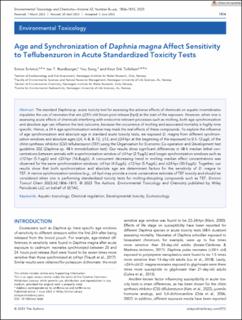| dc.description.abstract | The standard Daphnia sp. acute toxicity test for assessing the adverse effects of chemicals on aquatic invertebrates stipulates the use of neonates that are ≤24 h old (hours post release [hpr]) at the start of the exposure. However, when one is assessing acute effects of chemicals interfering with endocrine relevant-processes such as molting, both age synchronization and absolute age can influence the test outcome, because the occurrence of molting and associated mortality is highly time specific. Hence, a 24-h age synchronization window may mask the real effects of these compounds. To explore the influence of age synchronization and absolute age in standard acute toxicity tests, we exposed D. magna from different synchronization windows and absolute ages (≤4, 4–8, 8–12, ≤12, and ≤24 hpr at the beginning of the exposure) to 0.5–12 µg/L of the chitin synthesis inhibitor (CSI) teflubenzuron (TEF) using the Organisation for Economic Co-operation and Development test guideline 202 (Daphnia sp. 48 h immobilization test). Our results show significant differences in 48-h median lethal concentrations between animals with a synchronization window of ≤4 hpr (2.9 µg/L) and longer synchronization windows such as ≤12 hpr (5.1 µg/L) and ≤24 hpr (16.8 µg/L). A concurrent decreasing trend in molting median effect concentrations was observed for the same synchronization windows: ≤4 hpr (4.0 µg/L), ≤12 hpr (5.9 µg/L), and ≤24 hpr (30.0 µg/L). Together, our results show that both synchronization and absolute age are determinant factors for the sensitivity of D. magna to TEF. A narrow synchronization window (e.g., ≤4 hpr) may provide a more conservative estimate of TEF toxicity and should be considered when one is performing standardized toxicity tests for molting-disrupting compounds such as TEF. | en_US |

